MARIANI’S
Virtual
Gourmet
March
29, 2020
NEWSLETTER

❖❖❖
With countries trying to contain the spread of the COVID-19 by curbing travel into and out of them, as the publisher of Mariani’s Virtual Gourmet Newsletter I do not wish to advocate for travel anywhere that the virus is still raging. With regard to restaurants, most are closed by fiat so I am neither going to them nor writing about them for the near future. (But see New York Corner news below!) So, I will take a wait-and-see-attitude on others, I look forward to a safer, happier time in the near future when I can in good conscience begin to recommend the joy of travel everywhere in the world.
IN THIS ISSUE
BURGER MANIA
By John Mariani
NEW YORK CORNER
LOVE AND PIZZA
By John Mariani
NOTES FROM THE WINE CELLAR
KOSHER WINES FOR ANY
TIME OF THE YEAR
By Geoff Kalish
NEW YORK RESTAURATEURS HELPING
TO KEEP EMPLOYEES AFLOAT DURING PANDEMIC
By John Mariani
❖❖❖
❖❖❖
BURGER MANIA
By John Mariani
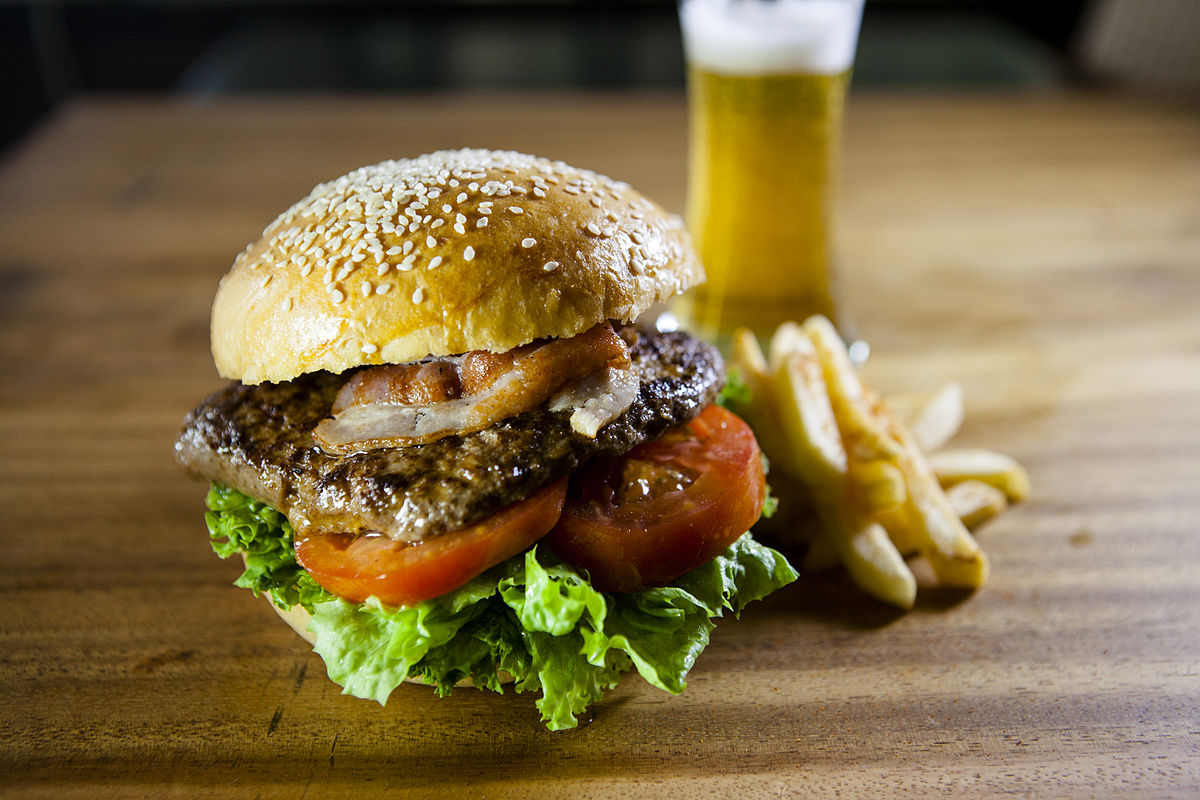
Red Dot Burger
 Well,
it’s a very American story. We love
nothing better than to take something small and
make it big, to transform something mundane into
the sublime, and to hype the hell out of something
that never needed to be hyped at all.
Well,
it’s a very American story. We love
nothing better than to take something small and
make it big, to transform something mundane into
the sublime, and to hype the hell out of something
that never needed to be hyped at all.
The
origins of the hamburger have been debated for
decades, but all we really know is that the
hamburger appeared in American eateries sometime
in the 19th century, the first mention in print—on
a menu—being 1834. By the 1890s the “hamburger” or
“Hamburg steak” was well known, so those 20th
century claimants from New Haven to Texas haven’t
much to base their assertions on.
By the 1920s chains like White Castle were
selling millions, and by the 1950s, when
McDonald’s exploded on the American scene, the
burger had come to be regarded as the
quintessential American food, with French fries a
close second.
No one back then, not even Popeye’s friend
Wimpy, thought much about hamburgers as symbols of
anything, nor did professors at Yale deconstruct
the architecture of luncheonettes as they might
the work of Frank Lloyd Wright. No one would have
considered compiling a book about the burger, like
the 321-page Encyclopedia
of Junk Food and Fast Food by Andrew F.
Smith with extensive entries on White Castle,
White Tower, Bob’s Big Boy, the In-N-Out Burger
chain and Jack in the Box. And who would ever have
thought that a bestseller would be entitled Fast Food
Nation, in which author Eric Schlosser
excoriates the American diet with titillating
questions like who knows “what really lurk between
those sesame seed buns?” and insisting “Eating in
the United States should no longer be a form of
high-risk behavior.”? The sensationalistic cover
line on the paperback was “The Dark Side of the
All-American Meal.”
Who knew? A
burger was a burger, though everyone has his own
favorite, and McDonald’s was a diversion that came
to be regarded in foreign countries as American as
bluejeans and Harleys. Schlosser’s and others’
assaults on the burger tried to make the little
patty-on-a-bun into a major
cause of every dietary malady known to man, and
for the past decade nothing had more scorn hurled
at it for contributing to our obesity and heart
disease. Meanwhile,
the hamburger chains kept mounting more and more
food onto those buns—double and triple burgers,
slathered with mayo, bacon, cheese, and God knows
what else.
a major
cause of every dietary malady known to man, and
for the past decade nothing had more scorn hurled
at it for contributing to our obesity and heart
disease. Meanwhile,
the hamburger chains kept mounting more and more
food onto those buns—double and triple burgers,
slathered with mayo, bacon, cheese, and God knows
what else.
And then
something weird happened. The burger made a big
comeback. It was like the perfect storm of
opposition. Fueled by the controversial
pronouncements of
the late Dr. Robert C. Atkins, that eating
lots and lots of protein and fat is a very
reasonable way to lose weight, and buoyed by new
nutritional reports that, in moderation, beef
provides all sorts of good nutrients,  Americans started to take another
look at one of their favorite foods, and, being
American, everything once simple became a big, big
deal.
Americans started to take another
look at one of their favorite foods, and, being
American, everything once simple became a big, big
deal.
Oddly enough, one of the first shots
against the nutritionalists’ bow came from an
haute cuisine French chef, Daniel Boulud (right). When
asked back in 2000 by a news reporter his response
to a French farmer’s protest against McDonald’s in
France, Boulud said, “The French are just jealous
they did not invent the hamburger themselves.” The
next day he came up with his own—a kind of inverse
tournedos Rossini—a classic ground sirloin burger
with a stuffing of wine-braised short ribs, foie
gras, a mirepoix of root vegetables, and preserved
black truffle, all sandwiched between a toasted
parmesan and poppy seed bun spread with fresh
horseradish, oven roasted tomato confit, fresh
tomato, red onions and frisée lettuce and served
with a big bunch of crispy pommes frites.
A year later, upon opening his casual db Bistro
Moderne, he put the oddity on the menu—right
at the height of the Atkins Diet craze—charging
$32, as the “db Burger Royale,” with lavish
shavings of fresh black truffles in black truffle
season. (Until
it closed this month, owing to the coronavirus,
the restaurant was charging $35.) Yet since
opening, about 40 percent of db Bistro Moderne’s
sales have been the now famous hamburger, and
Boulud has been thinking of putting up a sign that
reads “Over 300,000 Served!”
 Of
course, other top chefs had to follow suit, like
the late, globetrotting French chef Joël Robuchon,
who has opened a series of casual restaurants
called L’Atelier in Paris, London, Tokyo, Las
Vegas, and New York, offering a menu of
delicacies like sea urchin en gelée
with cauliflower cream right along with his “Le
Burger,” made with beef and foie gras and lightly
caramelized Bell peppers, which you eat at a
counter, just as you would at White Castle or
Howard Johnson’s.
Of
course, other top chefs had to follow suit, like
the late, globetrotting French chef Joël Robuchon,
who has opened a series of casual restaurants
called L’Atelier in Paris, London, Tokyo, Las
Vegas, and New York, offering a menu of
delicacies like sea urchin en gelée
with cauliflower cream right along with his “Le
Burger,” made with beef and foie gras and lightly
caramelized Bell peppers, which you eat at a
counter, just as you would at White Castle or
Howard Johnson’s.
When Danny Meyer, who owns high-end
restaurants like Gramercy Tavern and The Modern in
New York, opened Shake Shack
in the middle of Madison Square Park, its burger
was declared the best in the city by New York
magazine, exulting,
“No Kobe. No foie gras. No knife and fork
necessary—just an outdoor table, a bunch of
napkins and a frozen custard alongside. Pretty
much burger heaven.” (Shake Shack is now an
international chain.)
And therein lies a clue to the new fashion
for a better burger. Once a certain class of
Americans got over their anxieties about eating
red meat, and while the average American still
eats, even gorges, on chain  restaurant
hamburgers, people with $16 or $24 or $120 to
spend on a burger want to feel good inside and out
about what they’re eating. Thus,
if a chef advertises that his beef is all natural,
hormone-free, cuddled and kept away from mass
slaughterhouses, many people swallow the message,
feel less guilty about eating red meat and even
bask in the retro-chic glow of eating a hamburger
in a French bistro or department store café.
restaurant
hamburgers, people with $16 or $24 or $120 to
spend on a burger want to feel good inside and out
about what they’re eating. Thus,
if a chef advertises that his beef is all natural,
hormone-free, cuddled and kept away from mass
slaughterhouses, many people swallow the message,
feel less guilty about eating red meat and even
bask in the retro-chic glow of eating a hamburger
in a French bistro or department store café.
These days not a week goes by without the
food media hyping a new and extravagant burger,
usually served up in a hip “scene” in Brooklyn or
East L.A. with a line around the block and a
two-hour wait . . . for a burger. Don’t get me
started on the absurdity of veggie burgers!
I’ve
never
been a fan of the big chains’ burgers—McDonald’s,
Wendy’s, Burger King—but I love the distinctive
tastes of those at In-N-Out Burger and
Fatburger out of California, and
Fuddrucker’s out of Texas. And I’ve never had a
bad burger at an American diner. Yet I have to say
that in our pursuit of the better burger we may
have lost a great deal of the joy an American
takes in a merely good burger, one that’s not too
large or plowed under and overwhelmed by other
ingredients, a burger where the meat is the
message and a little Heinz’s ketchup gets on your
shirt.
❖❖❖
By John Mariani
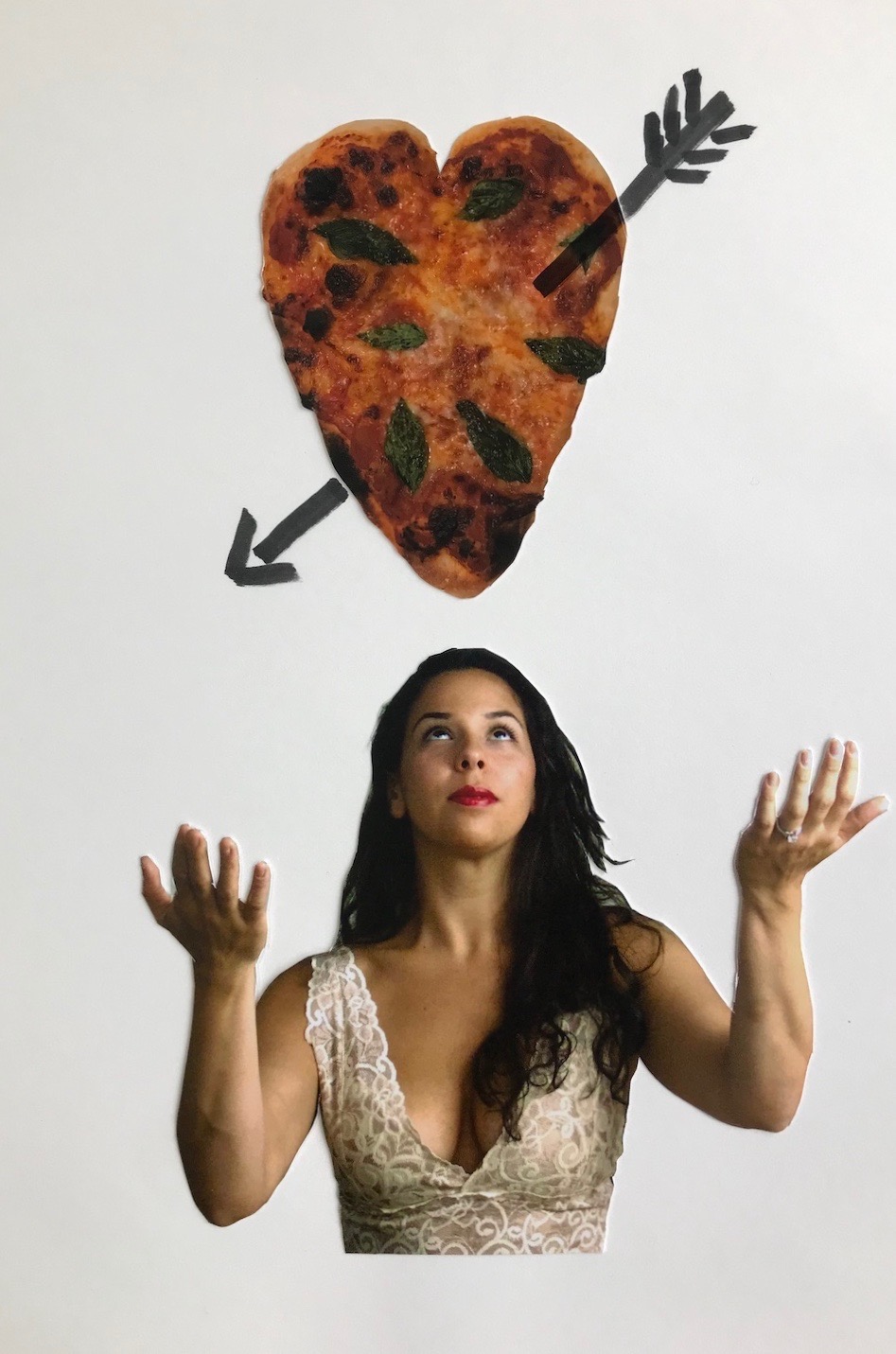
Cover Art By Galina Dargery
© John Mariani, 2020
Since,
for the time being, I am unable to write about
or review New York City
restaurants, I have decided instead to print a
serialized version of my (yet unpublished)
novel Love
and Pizza,
which takes place in New York and
Italy and involves a young, beautiful
Bronx woman named Nicola Santini from an
Italian family impassioned about food.
As the story goes on, Nicola, who is a student
at Columbia University, struggles to maintain
her roots while seeing a future that could
lead her far from them—a future that involves
a career and a love affair
that would change her life forever. So, while
New York’s restaurants remain closed, I will
run a chapter of the Love
and Pizza
each week until the crisis is over. Afterwards
I shall be offering the entire book
digitally. I hope you like
the idea and even more that you will love
Nicola, her family and her friends. I’d love
to know what you think. Contact me at
loveandpizza123@gmail.com
—John Mariani
CHAPTER ONE
“Nicola,
listen. Always stir the sauce clockwise.”
“Yes,
Grandma.
You always tell me that.”
“Is very
important you don’t forget. Is
a holy direction.”
Nicola
Santini had indeed heard her grandmother’s
mantra on sauce stirring a thousand times, but
she never tired of it because she heard it
whenever they were cooking together at her
grandmother’s house on Cambreleng Avenue in
the Italian neighborhood known as Belmont in
the north Bronx.
“You cook like this,” said her grandmother,
Teresa, inserting a fork into the beef stewing
in the ancient sauce pot, “you gonna see all
the men line up to marry you.”
“Do I
really want that?” asked her dark-haired,
brown-eyed 20-year-old granddaughter.
“Si,
you have them all at your mercy, then you pick
the best one! You no gonna just marry some gavone.”
"Then
we’re on the same page, Grandma,” said Nicola,
sticking a crust of bread into the sauce and
eating it.
“Grandma, the sauce is as good as
ever.”
Teresa
looked mildly surprised, as if there could
have been any other outcome, then, wiping her
hands on a moppine,
said, “Listen, Nicola, you the smartest girl
in the family—sshh! Don’t tell your mama I say
so!—but you are. I love your sisters, but
they no have your mind and your bellezza. The
girls, they gonna be fine, but you, you
going to make us all proud. You
don’t settle for nothin’ or nobody.”
Nicola, who was called
Nicky by her brothers, sisters and friends,
hugged her eighty-year-old nonna
and, mimicking her accent, said, "Promise! I
won’t settle for nothin’ or nobody.”
“I tell
you, Nicolina, that’s why you learn to cook
like this.
You can't just be a smart girl. You
gotta be an Italian female, and we all know
how to cook,” then, tilting her head and
smiling, “Some better than others.”
Nicola
smiled too, knowing that Teresa was really
claiming to be the family’s, maybe even the
neighborhood’s, best cook. Nicola knew the
truth of her grandmother’s indirect boast,
having eaten every weekend meal of her life at
her mother’s or grandmother’s or at countless
aunts’ houses, along with a few meals at
sisters-in-law, who were always terrified when
the Santinis came to dinner.
The
Santinis were not known for serving the most
lavish meals—that
would be Nicola’s aunt Rosa, who made up for
what she lacked in culinary subtlety by
turning out spreads that began with melon and
prosciutto-wrapped breadsticks, slabs of fresh
mozzarella, marinated eggplant, peppers and
artichokes, followed by two pastas, one
spaghetti, one stuffed, maybe lasagna or
ravioli, then both chicken and a roast pork or
veal, with potatoes or polenta, asparagus with
grated cheese on top,
and then cuts of cheese and fruit served in a
bowl of cold water,
then cannoli and some other dessert, with
espresso, digestivi,
and Italian cookies. People always left Rosa’s
table full and happy, but often groaning.
Teresa stayed silent at such meals
because she thought it was too much food made
without any finezza. Her meals
were always impeccably rendered, very
beautiful and balanced, and if people wanted
second helpings, she’d shrug and say, “Go
ahead. Stuff yourself!”
Teresa’s meals would start with
whatever vegetables she found freshest in the
market, then she’d serve a pasta with just
enough sauce to coat the spaghetti or rigatoni
or farfalle
or whatever she decided was the ideal
shape for the particular sauce. She
would also make her own fresh pastas,
amazingly light potato gnocchi that
she shaped with her fingers, applying slight
indentations with the tines of a fork in order
for the gnocchi to catch the sauce better.
Next
would come the main course—perhaps a beef
stew, whose own sauce often served as the
sauce for the pasta before it—perhaps with
potatoes, and the meal would end simply with
fruit and cheese. If
anyone was still hungry, there was always a
package of Stella d’Oro cookies in the
cupboard.
So
despite the relative size of Teresa’s meals
(versus her relatives’)
everyone looked forward most to dinner at her
house and never left less than wholly
satisfied.
Nicola
was the one who always marveled at her
grandmother’s finezza,
the care she took with every gnocchi dumpling,
as if she were handling rosary beads. Teresa
had taken particular care to make sure Nicola
learned to cook the right way, especially
since the other two Santini granddaughters did
not show much interest in the subject, shy of
learning to make a basic tomato
sauce. Whatever secrets there were to Teresa’s
cooking, she passed them on to Nicola.
Nicola cherished every
moment with her grandmother, not only because
she was a great cook but because she was
different from most of the other Italians in
the neighborhood. Teresa had come from
Emilia-Romagna in northern Italy, which was
rare among the immigranti who arrived in America
in the late 19th and early 20th century,
overwhelmingly from southern
provinces like Campania, the Abruzzi,
Calabria, Basilicata, Puglia and the island of
Sicily.
In fact, of the five million southern
Italians who emigrated to America between 1890
and 1910, one out of every four was a
Sicilian.
Northern Italians looked down upon the
southerners and the southerners looked down
upon the Sicilians farther south, barely
acknowledging them as being Italian at all,
instead referring to them as africani.
To come from
Emilia-Romagna, in Teresa’s case Bologna, was
regarded as quite unusual in the Belmont
section of the Bronx, which had been settled
largely by Italian masons who came over to
work on the elaborate stonework of the nearby
Bronx Zoo and Botanical Gardens. Those
who didn't know Teresa well always assumed she
came from a higher station than the usual
paisans and laborers who fled the South in
order to have some kind of future for
themselves and their children. Bologna
was known as “La Grassa”—the
fat
one—famous for its abundance of food and its
industry, though at the turn of the century
few people of Bologna would ever characterize
themselves as living high on the hog.
By her own admission,
Teresa had a superior attitude towards the
Southerners she came over with, finding many
of them coarse, speaking dialects that bore
little resemblance to formal Italian. So
her marriage to Federico Santini,
who came from a town on the Adriatic coast in
the Abruzzi—a province east of Rome that
encompassed Abruzzo and Molise, more
in the middle than in the south of the Italian
boot—was considered something of a coup for
the Santini family. The fact that Federico
had worked in the millinery crafts and was
not, therefore, a contadina
peasant like most of his neighbors in
Belmont, provided him, too, with a certain
cachet, which in some quarters brought resentment and envy. There
were several nasty slur words used for
anyone they thought had even a whiff of
being a snob—parassita,
ciabbattino, and millantore.
In the years when Nicola’s
grandparents’ generation of Italians emigrated
to the United States, they’d been ushered
through the vast halls of Ellis Island, where
they were examined for diseases, sometimes
quarantined for weeks offshore, sometimes sent
back to Italy. Their names were recorded—often
misspelled, even changed, because the
immigrants were illiterate
and could not spell them out.
Once
settled in the New World the newcomers became
one of two minds.
There were those who would always
regard Italy as their homeland and wished to
return when they’d earned enough money. They
would always lament leaving Italy, evident in
all the sobbing songs like “Torna a
Surriento” (Come Back to Sorrento), and
of how much they so desperately missed the Old
Country, despite the deprivations they had for
centuries suffered there.
The other
group of immigrants came to America with an
enduring antipathy for Italy, regarding their
lives there as dire and hopeless, scraping by
on farms they did not own, where they paid a
landlord to live and work there for him. It
was a country where children worked in coal
mines and infant mortality was unconscionably
high; a place where there was never enough to
eat, where harvesters picked up the bits of
grain that had fallen to the ground to use
that night to make a hard, meager bread.
Those immigrants had not
the slightest desire to return to Sorrento, or
anywhere else in Italy, content to make their
way in their newly adopted country, where a
poor family could feed and clothe their
children, even send them all to
school—free!—and to indulge the hope that
their sons and daughters, grandsons and
granddaughters, could break forever the
age-old cycle of poverty and to enter into
every industry and into every profession of
American society. Never expecting “streets
of gold,” they sought
instead streets of markets
and stores run by other immigrants who treated
them with rispetto!
These immigrants
were the ones who let their dialects go dry
and didn’t bother to teach the language to
their children, except through osmosis at
home. Indeed,
some parents spoke in an esoteric dialect only
in order to hide what they were saying from
the children.
They were proudly American and Italy
could be damned.
Federico Santini fell more
into the first kind of immigrant, though he
came to love America more than he could have
imagined after arriving in 1910. Teresa
Guardini Santini, who came with her parents
ten years later, however, straddled both
attitudes: she was extremely proud of being
both Italian and American
and sought to imbue her children and
grandchildren with an abiding appreciation of
all America had done for them. At
the same time, she perpetuated a pride in all
the greatness, all the beauty, all the
influence that Italy had had on the
world.
She made it a
point always to wear earrings and colorful
dresses with flower prints, eschewing the drab
black dresses most Italian women her age wore
almost like a nun’s habit. She
told the family that she’d already picked out
the clothes and jewelry she wanted to be waked
in—an orchid-colored silk dress with a green
sash, with a silver cross at her neck, and on
her wrist the charm bracelet she’d worn since
she was a child. It was all neatly packed
in a box with pink tissue paper, set on the
top of the closet in her bedroom.
❖❖❖
KOSHER WINES FOR
ANY TIME OF THE YEAR
By Geoff Kalish
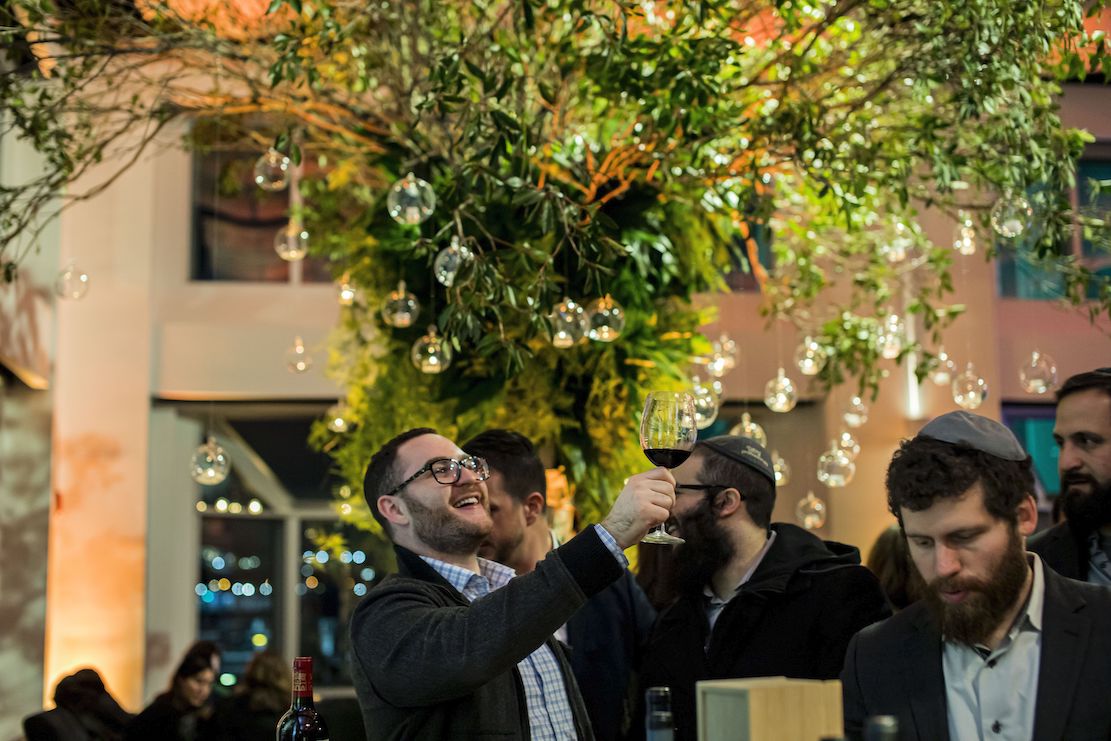
In
addition to the syrupy, sweet red, Concord
grape-based wines sold in jug-size containers,
many retail shop shelves now carry a variety of
dry and semi-sweet reds and whites produced
kosher-for-Passover. And while many consumers
continue to use the sweet reds for the
ceremonial part of the Passover seder meal, even
traditionalists are switching to these lighter,
more enjoyable reds and whites for the actual
dinner, with bottles from Israel and California
topping the list.
 What allows these
lighter, less sweet wines to be consumed, even in
the most orthodox of homes, is that they are
produced by a “sanctioned” process that involves a
number of written and unwritten regulations. For
example, work performed in the process may not be
conducted on the Jewish sabbath or other religious
holy days, and non-kosher products may not be used
in production. (This last proscription comes into
play because to clear sediment from wine, some
producers use animal protein, in order to clump
particles in the fermented juice and let them
settle to the bottom of the tank or barrel. But
unless it can be certified that the animal from
which the protein was derived was raised and
slaughtered according to strict kosher rules, this
is prohibited.)
What allows these
lighter, less sweet wines to be consumed, even in
the most orthodox of homes, is that they are
produced by a “sanctioned” process that involves a
number of written and unwritten regulations. For
example, work performed in the process may not be
conducted on the Jewish sabbath or other religious
holy days, and non-kosher products may not be used
in production. (This last proscription comes into
play because to clear sediment from wine, some
producers use animal protein, in order to clump
particles in the fermented juice and let them
settle to the bottom of the tank or barrel. But
unless it can be certified that the animal from
which the protein was derived was raised and
slaughtered according to strict kosher rules, this
is prohibited.)
Also, in order
for a wine to be “certified” as kosher and/or
kosher-for-Passover the entire winemaking process,
including viticulture, vinification and bottling,
must be supervised and certified by a rabbi.
Moreover, for kosher wine produced in Israel,
grapes cannot be used to make wine for the first
three years of growth, other products cannot be
grown between the grapes, the vineyard must be
left fallow every seven years, and a small part of
the crop at any vineyard  must be left on the vine
for those who cannot afford to grow their own
grapes (a situation known as “gleaning”). Also,
some (especially the very orthodox) require that a
wine be “meshuval”
(pasteurized) so that if a non-Jew serves the wine
it remains kosher. In addition, to be
“kosher-for-Passover,” during the entire process
the wine cannot have been in contact with grain,
bread or dough, which in actuality makes most
kosher wines also kosher-for-Passover, but, in
addition (just to be sure), some wineries totally
sterilize their wine equipment before producing
“kosher-for-Passover” bottles.
must be left on the vine
for those who cannot afford to grow their own
grapes (a situation known as “gleaning”). Also,
some (especially the very orthodox) require that a
wine be “meshuval”
(pasteurized) so that if a non-Jew serves the wine
it remains kosher. In addition, to be
“kosher-for-Passover,” during the entire process
the wine cannot have been in contact with grain,
bread or dough, which in actuality makes most
kosher wines also kosher-for-Passover, but, in
addition (just to be sure), some wineries totally
sterilize their wine equipment before producing
“kosher-for-Passover” bottles.
Even with all these
requirements, a recent tasting of kosher and
kosher-for-Passover wines held at New York’s
Chelsea Piers included over 50 brands, primarily
from Israel and the United States. And the
following are comments on my top picks,
categorized by the Passover fare they are best
suited to mate. (Prices listed are the average
retail cost.)
 Probably the most
difficult match is wine to go with appetizers of
chopped liver and gefilte fish (boiled fish
dumplings), often served with nose-cleansing
horseradish. Wines with a bit of sweetness and a
crisp finish seem to be best, and three whites
meeting the requirement are Moscatos from
Bartenura and Weinstock and a Riesling from
Hagafen Cellars. The 2018
Weinstock Moscato ($9) from California has a
bouquet and off-dry taste of ripe peaches and
apricot and a refreshing finish. The 2017 Hagafen
Cellars Napa Valley White Riesling ($27)
exhibits a floral bouquet and sweet, yet pleasant,
taste of mango and papaya and a citrusy finish.
And the bubbly 2018 Bartenura
Moscato ($12) from Italy shows a bouquet and
semi-sweet taste of peaches and melons with a
lively acidity in its finish.
Probably the most
difficult match is wine to go with appetizers of
chopped liver and gefilte fish (boiled fish
dumplings), often served with nose-cleansing
horseradish. Wines with a bit of sweetness and a
crisp finish seem to be best, and three whites
meeting the requirement are Moscatos from
Bartenura and Weinstock and a Riesling from
Hagafen Cellars. The 2018
Weinstock Moscato ($9) from California has a
bouquet and off-dry taste of ripe peaches and
apricot and a refreshing finish. The 2017 Hagafen
Cellars Napa Valley White Riesling ($27)
exhibits a floral bouquet and sweet, yet pleasant,
taste of mango and papaya and a citrusy finish.
And the bubbly 2018 Bartenura
Moscato ($12) from Italy shows a bouquet and
semi-sweet taste of peaches and melons with a
lively acidity in its finish.
Wines with a fruity bouquet and
taste of cranberries and plums make ideal
accompaniment for popular main course items like
duck and lamb and chicken casseroles, like orange
chicken and heady chicken Marengo made with
tomato, herbs and olives. Three wines that fill
the bill are: a 2016 Barkan
Classic Pinot Noir ($12) from Israel, and
from California a 2018 Baron Herzog Lineage Pinot Noir
($18) and a 2018 Hagafen
Cellars Estate Bottled Pinot Noir ($33).
Dry reds with flavors of black
currants and herbs and a bit of tannin in their
finish seem to marry well with most main courses
of roasted and/or braised beef. A worthy mate of
note is the 2017
Binyamina Cabernet Sauvignon ($23) from
Israel’s Galilee region, which has notes of orange
in addition to some tannin in its finish. Two
other notable bottles that answer the call are the
2016 Barkan
Reserve Cabernet Sauvignon ($15) from the
Hulda area in central Israel and the 2018 Gamila
Cabernet Sauvignon ($17) from Israel’s Golan
Heights.
And dry, flavorful whites—a
once unheard-of category of kosher-for-Passover
wines—are ideal for the likes of roasted chicken
and rock Cornish game hens (popular Passover main
courses). Three good choices in this category are
from Tzuba and Yarden in Israel, and Baron Herzog
in California. The 2016 Tzuba
Chardonnay ($22), from Israel’s Judean
Hills, shows flavors of apples and some pineapple
and just a bit of oak in its crisp finish. The 2017 Baron
Herzog Sauvignon Blanc ($12) from California
has a bouquet and taste of grapefruit with some
lychee in its finish, and the 2017 Yarden
Gewürztraminer ($23) from Israel’s northern
Golan Heights has a bouquet and taste of tropical
fruit and a hint of cloves with a vibrant finish.
Of importance, these three whites should be served
well chilled to bring out their acidity, which
enhances the flavor of these wine and food
combinations.
TO KEEP EMPLOYEES AFLOAT DURING PANDEMIC
By John Mariani
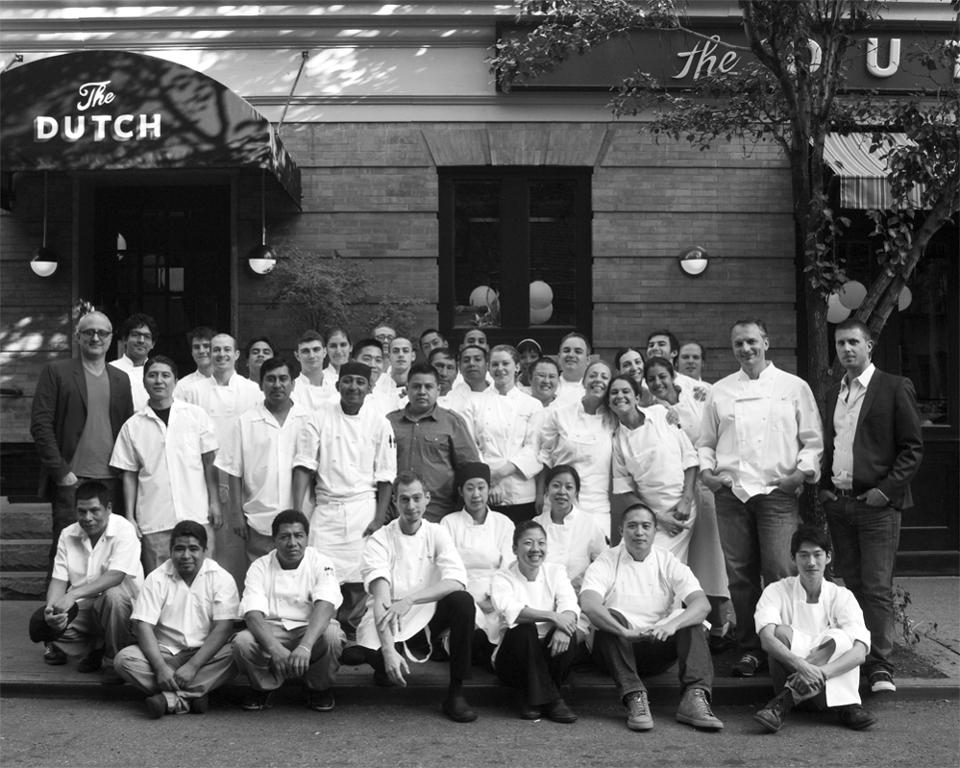
The Dutch Staff
Allowed
to stay open only if they offer take-out and/or
delivery of food, New York’s restaurateurs have
responded in a variety of ways, from setting up
auctions to donating their salaries to employees.
Many have utilized GoFundMe as a way to accrue
money to help their staff get through the current
coronavirus crisis, which effects 500,000 workers
in New York’s 30,000 independent restaurants.
As reported in Grubstreet.com,
“The most effective, fast-moving
action is a three-tiered approach: A group called
the Independent
Restaurant Coalition, which formed just last
week, works at the federal level. The newly
formed Relief Opportunities
for All Restaurants (ROAR) works with Governor
Cuomo’s office at the state level. And the New
York City Hospitality Alliance works at the city level with
Mayor Bill de Blasio’s office. Stephanie Cutter,
the founding partner of Precision
Strategies in Washington, D.C., started
working with the IRC last week.
Danny Meyer of USHG
restaurants, which include Gramercy Tavern and the
Shake Shack chain announced, "We have created a relief
fund to help the employees affected by the layoffs
today. To seed the effort, I’m immediately
contributing my entire compensation, and our
executive team is taking a meaningful pay cut. We
will use these funds and other donations we
collect to help those on our team that will face
significant financial hardship in the weeks
to come. Through March 24, 100% of the revenue
generated by USHG gift
cards purchased on our site will be
directed toward that fund. We ask that friends of
USHG restaurants join us in this effort.”
https://ecommerce.custcon.com/Selection.aspx?c=D936B6A5-6CB9-42C7-8762-9BBEECC3C29D&utm_source=footer&utm_medium=web&&utm_content=ushg
Chef/owner
Daniel Humm of Eleven
Madison Park, a fine dining restaurant with
three Michelin stars, reports that “We
have set up an auction and donation page that you
can find at the link below. We have amazing
experiences and items to bid on, or we appreciate
a contribution of any dollar amount that you are
able to make. 100% of proceeds will go directly to
our world-class team here in New York City to help
them through the uncertainty ahead. Our biggest
shared worry is the lack of clarity as to what the
future holds – will this be days or weeks or
months? We just don’t know—so we’re trying to do
everything we can to help our team whether this
unprecedented
storm.” https://www.elevenmadisonpark.com.
Andrew Carmellini, Luke Ostrom and Josh Pickard of
NoHo
Hospitality, whose restaurants
include Locanda Verde and The Dutch, announced, “For
the next week through March 25th, 100% of every
NoHo Hospitality gift card you purchase will go to
our NoHo Hospitality Family Fund, supporting team
members affected by this crisis. Treat yourself to
a future night out at any of our restaurants! Our
team needs your support now, more than ever.” They
also have a donation link through GoFundMe. https://www.gofundme.com/f/wpnza-noho-hospitality-family-fund
Here is a list of
other New York restaurants links
to their charitable efforts.
Gabriel
Kreuther: https://www.gofundme.com/f/46eunw-stay-strong
Thomas
Keller: https://www.thomaskeller.com/donate
Delicious
Hospitality Group: https://www.gofundme.com/f/delicious-hospitality-group-family-fund
Le
Bernardin: https://www.gofundme.com/f/le-bernardin-amp-aldo-sohm-wine-bar-family-fund
AvroKo
Hospitality Group, which includes
Ghost Donkey, Saxon & Parole, and the Poni
Room, has raised $19,000 so far through
https://www.gofundme.com/f/avroko-hospitality-group-staff-relief-fund?utm_source=customer&utm_medium=copy_link-tip&utm_campaign=p_cp+share-sheet
Contra
| Wildair https://www.gofundme.com/f/contrawildairpeoples-workers-fund
Serafina GoFundMe
"Serafina Family Fund" “All donations will
go directly to our restaurant employees and their
families. No gift is too small.”
Las
lap
https://www.gofundme.com/f/las039-lap-employee-relief-fund?utm_source=facebook&utm_medium=social&utm_campaign=p_cp+share-sheet
Sugarmonk
https://www.gofundme.com/f/sugar-monk-nyc-staff-emergency-fund
The
Dead Rabbit
https://www.gofundme.com/f/the-dead-rabbit-relief-fund
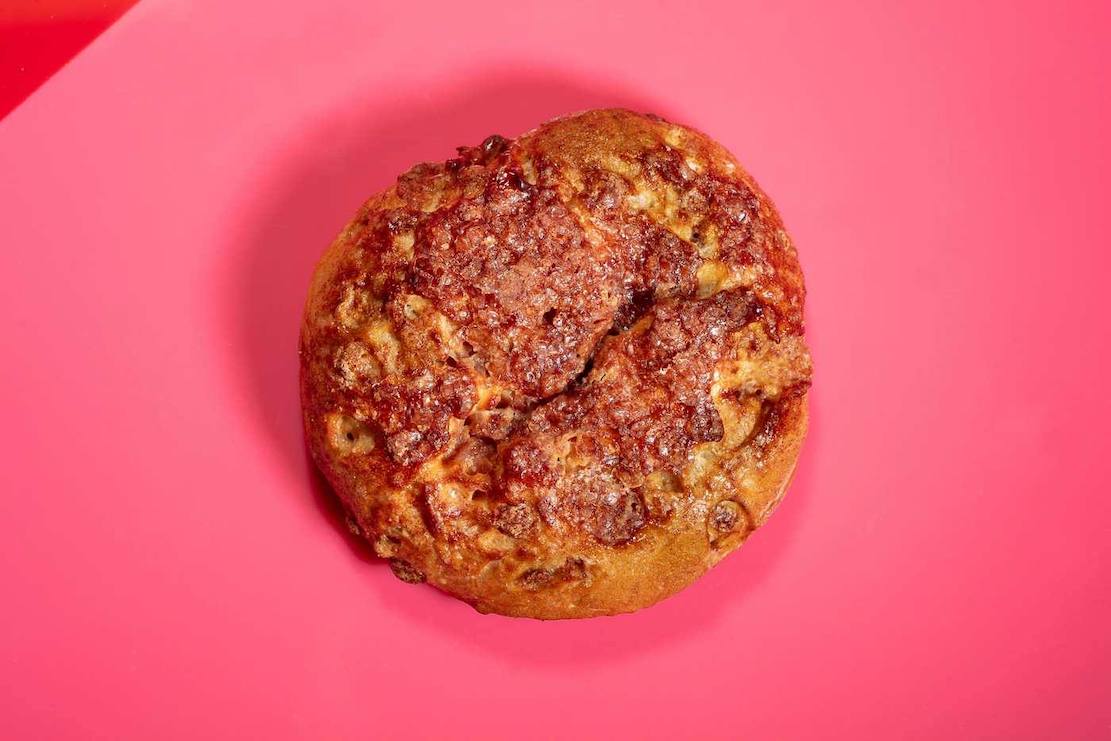
FOR PETE'S SAKE! IS
IT OR IS IT NOT A BAGEL?
"Let’s be clear: It does not hold a
candle to the sesame bagel from Russ &
Daughters or the bright-orange egg number
they serve at Absolute Bagels. Yet I feel no shame championing
this bagel to even the most ardent East Coast bagel
purists, because this is not really a bagel. It
clocks in at 420 calories and has 82 grams of carbs.
It is the equivalent of eating roughly eight Oreos,
and it is almost as sweet. Somehow, this is a food
item that is still recognizably a bagel, but it has
liberated itself from its inherent bagelness to
become something else, something far more
dessertlike. It could be considered a breakfast
food, but only if you also consider cookies to be
breakfast food.—Juan Vidal, “This Bagel Is Actually
a Perfect Dessert. “ New York, Feb 25, 2020.
'WACKY' DOES NOT BEGIN TO DESCRIBE IT.
"DOPEY' KIND OF WORKS. 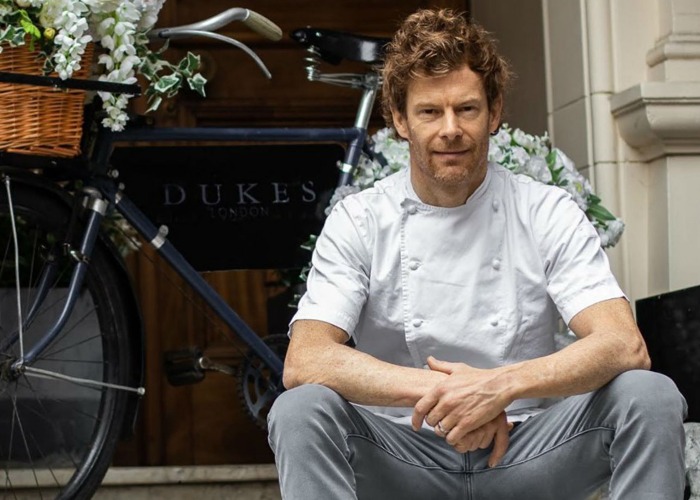
Any of John Mariani's books below may be ordered from amazon.com.
 The Hound in Heaven
(21st Century Lion Books) is a novella, and
for anyone who loves dogs, Christmas, romance,
inspiration, even the supernatural, I hope you'll find
this to be a treasured favorite. The story
concerns how, after a New England teacher, his wife and
their two daughters adopt a stray puppy found in their
barn in northern Maine, their lives seem full of promise.
But when tragedy strikes, their wonderful dog Lazarus and
the spirit of Christmas are the only things that may bring
his master back from the edge of despair.
The Hound in Heaven
(21st Century Lion Books) is a novella, and
for anyone who loves dogs, Christmas, romance,
inspiration, even the supernatural, I hope you'll find
this to be a treasured favorite. The story
concerns how, after a New England teacher, his wife and
their two daughters adopt a stray puppy found in their
barn in northern Maine, their lives seem full of promise.
But when tragedy strikes, their wonderful dog Lazarus and
the spirit of Christmas are the only things that may bring
his master back from the edge of despair. WATCH THE VIDEO!
“What a huge surprise turn this story took! I was completely stunned! I truly enjoyed this book and its message.” – Actress Ali MacGraw
“He had me at Page One. The amount of heart, human insight, soul searching, and deft literary strength that John Mariani pours into this airtight novella is vertigo-inducing. Perhaps ‘wow’ would be the best comment.” – James Dalessandro, author of Bohemian Heart and 1906.
“John Mariani’s Hound in Heaven starts with a well-painted portrayal of an American family, along with the requisite dog. A surprise event flips the action of the novel and captures us for a voyage leading to a hopeful and heart-warming message. A page turning, one sitting read, it’s the perfect antidote for the winter and promotion of holiday celebration.” – Ann Pearlman, author of The Christmas Cookie Club and A Gift for my Sister.
“John Mariani’s concise, achingly beautiful novella pulls a literary rabbit out of a hat – a mash-up of the cosmic and the intimate, the tragic and the heart-warming – a Christmas tale for all ages, and all faiths. Read it to your children, read it to yourself… but read it. Early and often. Highly recommended.” – Jay Bonansinga, New York Times bestselling author of Pinkerton’s War, The Sinking of The Eastland, and The Walking Dead: The Road To Woodbury.
“Amazing things happen when you open your heart to an animal. The Hound in Heaven delivers a powerful story of healing that is forged in the spiritual relationship between a man and his best friend. The book brings a message of hope that can enrich our images of family, love, and loss.” – Dr. Barbara Royal, author of The Royal Treatment.
 |
The Encyclopedia of American Food and Drink by John F. Mariani (Bloomsbury USA, $35) Modesty forbids me to praise my own new book, but let me proudly say that it is an extensive revision of the 4th edition that appeared more than a decade ago, before locavores, molecular cuisine, modernist cuisine, the Food Network and so much more, now included. Word origins have been completely updated, as have per capita consumption and production stats. Most important, for the first time since publication in the 1980s, the book includes more than 100 biographies of Americans who have changed the way we cook, eat and drink -- from Fannie Farmer and Julia Child to Robert Mondavi and Thomas Keller. "This book is amazing! It has entries for everything from `abalone' to `zwieback,' plus more than 500 recipes for classic American dishes and drinks."--Devra First, The Boston Globe. "Much needed in any kitchen library."--Bon Appetit. |
"Eating Italian will never be the same after reading John Mariani's entertaining and savory gastronomical history of the cuisine of Italy and how it won over appetites worldwide. . . . This book is such a tasteful narrative that it will literally make you hungry for Italian food and arouse your appetite for gastronomical history."--Don Oldenburg, USA Today. "Italian
restaurants--some good, some glitzy--far
outnumber their French rivals. Many of
these establishments are zestfully described
in How Italian Food Conquered the World, an
entertaining and fact-filled chronicle by
food-and-wine correspondent John F.
Mariani."--Aram Bakshian Jr., Wall Street
Journal.
"Equal parts
history, sociology, gastronomy, and just
plain fun, How Italian Food Conquered the
World tells the captivating and delicious
story of the (let's face it) everybody's
favorite cuisine with clarity, verve and
more than one surprise."--Colman Andrews,
editorial director of The Daily
Meal.com. "A fantastic and fascinating
read, covering everything from the influence
of Venice's spice trade to the impact of
Italian immigrants in America and the
evolution of alta cucina. This book will
serve as a terrific resource to anyone
interested in the real story of Italian
food."--Mary Ann Esposito, host of PBS-TV's
Ciao
Italia. "John Mariani has written the
definitive history of how Italians won their
way into our hearts, minds, and
stomachs. It's a story of pleasure over
pomp and taste over technique."--Danny Meyer,
owner of NYC restaurants Union Square
Cafe, The Modern, and Maialino.
|
 |
 |
 |
 |
 |
 |
 |
 |
 Everett Potter's Travel Report:
Everett Potter's Travel Report: 
 Eating Las Vegas
JOHN CURTAS has been covering the Las Vegas
food and restaurant scene since 1995. He is
the co-author of EATING LAS VEGAS – The 50
Essential Restaurants (as well as
the author of the Eating Las Vegas web site: www.eatinglasvegas.
He can also be seen every Friday morning as
the “resident foodie” for Wake Up With the
Wagners on KSNV TV (NBC) Channel 3 in
Las Vegas.
Eating Las Vegas
JOHN CURTAS has been covering the Las Vegas
food and restaurant scene since 1995. He is
the co-author of EATING LAS VEGAS – The 50
Essential Restaurants (as well as
the author of the Eating Las Vegas web site: www.eatinglasvegas.
He can also be seen every Friday morning as
the “resident foodie” for Wake Up With the
Wagners on KSNV TV (NBC) Channel 3 in
Las Vegas.
MARIANI'S VIRTUAL GOURMET
NEWSLETTER is published weekly. Publisher: John Mariani. Editor: Walter Bagley. Contributing Writers: Christopher Mariani,
Robert Mariani, Misha Mariani, John A. Curtas, Gerry Dawes, Geoff Kalish,
and Brian Freedman. Contributing
Photographer: Galina Dargery. Technical
Advisor: Gerry
McLoughlin.
If you wish to subscribe to this
newsletter, please click here: http://www.johnmariani.com/subscribe/index.html
© copyright John Mariani 2020

